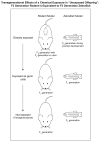Dioxin induction of transgenerational inheritance of disease in zebrafish
- PMID: 25194296
- PMCID: PMC4262573
- DOI: 10.1016/j.mce.2014.08.011
Dioxin induction of transgenerational inheritance of disease in zebrafish
Abstract
Dioxin (2,3,7,8-tetrachlorodibenzo-p-dioxin; TCDD) is an aryl hydrocarbon receptor (AHR) agonist, an endocrine disruptor, and a potent global pollutant. TCDD exposure is associated with diseases of almost every organ system, and its toxicity is highly conserved across vertebrates. While the acute developmental effects of dioxin exposure have been extensively studied, the ability of early sublethal exposure to produce toxicity in adulthood or subsequent generations is poorly understood. This type of question is difficult to study because of the time frame of the effects. With human subjects, such a study could span more than a lifetime. We have chosen zebrafish (Danio rerio) as a model because they are vertebrates with short generation times and consistent genetic backgrounds. Zebrafish have very modest housing needs, facilitating single and multigenerational studies with minimal time and expense. We have used this model to identify transgenerational effects of TCDD on skeletal development, sex ratio, and male-mediated decreases in reproductive capacity. Here we compare these findings with transgenerational effects described in laboratory rodent species. We propose that the zebrafish is a cost-effective model system for evaluating the transgenerational effects of toxic chemicals and their role in the fetal basis of adult disease.
Keywords: AHR; Epigenetic; Rodent; TCDD; Transgenerational; Zebrafish.
Copyright © 2014 Elsevier Ireland Ltd. All rights reserved.
Figures

References
-
- Abbott BD, Perdew GH, Buckalew AR, Birnbaum LS. Interactive regulation of Ah and glucocorticoid receptors in the synergistic induction of cleft palate by 2,3,7,8-tetrachlorodibenzo-p-dioxin and hydrocortisone. Toxicol Appl Pharmacol. 1994;128:138–150. - PubMed
Publication types
MeSH terms
Substances
Grants and funding
LinkOut - more resources
Full Text Sources
Other Literature Sources

